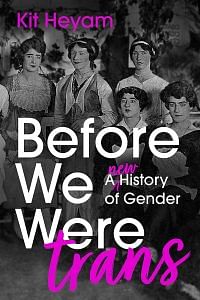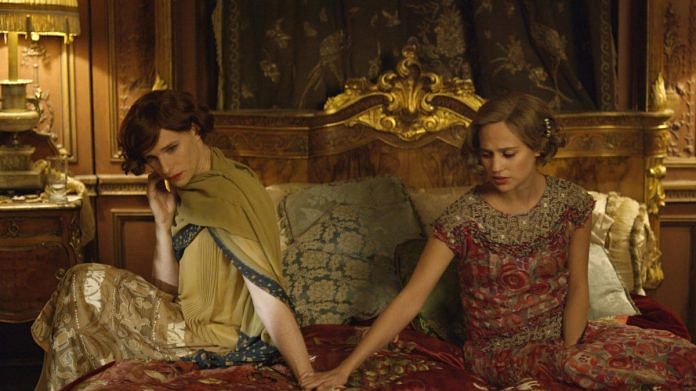What made the gender nonconformity of the camps possible was the long tradition of onstage gender nonconformity in Britain and elsewhere. The theatres of Ancient Greece, of sixteenth- and early-seventeenth-century England, and of early-twentieth- century British and American universities all had AMAB actors playing female parts; in the latter two contexts, this led to anxiety that male audience members would experience inadvertent but inescapable queer attraction.
Not all cultures saw a linear progression from theatrical segregation to theatrical diversity: in Beijing, for example, women had been performing on stage for over 500 years when they were banned from doing so in the eighteenth century. But in Europe and the USA, the trend did move gradually towards mixed-gender casting, often (and with particular intensity in the twentieth century) because of growing anxieties about the connection between onstage gender nonconformity and offstage queer sexuality.
There is plenty of evidence to suggest that this widespread onstage gender nonconformity acted to create or facilitate trans experience. In early modern mainland Europe, particularly Italy, the popularity of operatic castrati meant that theatrical performance facilitated both a form of medical transition (castration) and social transition (in Rome, castrati often presented as women offstage, using this in part to signal their availability for queer sex).
Literary scholar Simone Chess has researched the careers of the young people who played female roles on the early modern English stage, and found that many of them did not transfer smoothly to normative male roles when they reached adulthood. Instead, they continued to play roles that emphasised their androgyny or femininity, disrupted heteronormative plots, and sometimes even relied on the audience’s knowledge that they had previously performed as women – suggesting that their early reputations for female presentation meant they were never straightforwardly read as male again. One, Edward Kynaston – who gained a reputation as ‘the last male leading lady of the Renaissance stage’ – was described by Samuel Pepys as both ‘the prettiest woman in the whole house’ and ‘the handsomest man in the house’ during the same performance. After their death, the theatre historian John Downes doubted ‘whether any Woman that succeeded [Edward] so Sensibly touch’d the Audience’ as they did.
Onstage gender nonconformity did not, of course, disappear from the European or American stage once AFAB actors were permitted (which happened in England as early as the 1660s). ‘Female impersonators’ (AMAB actors playing women) and ‘male impersonators’ (AFAB actors playing men) had different origins, but both reached high levels of popularity in theatrical comedies and music-hall acts.
Also read: Temple chariots to thangkas – Appliqué, sewing technique that existed since 12th century in India
AMAB vaudeville, music-hall and blackface minstrel performers began to add characters of older, working-class Black and white women to their acts during the first half of the nineteenth century; soon afterwards they found their way into pantomimes, and their popularity was bolstered significantly by the caricatures of men in deliberately unconvincing female ‘disguises’ who filled the stage of plays like Charley’s Aunt (1892).56 In early British cinema, too, female disguises were used by comic criminals, lovers and practical jokers, and reviewers praised the technological ingenuity of their quick transformations. By contrast, ‘male impersonation’ was a separate tradition from the AFAB ‘principal boy’ of the pantomime. ‘Male impersonation’ was born in the music-hall in the second half of the
nineteenth century, and was far removed from the working-class characters of the ‘female impersonator’, instead skewering the pretensions of dandies, cads and fashionable lovers. While white music-hall ‘male impersonators’ declined in the early twentieth century, particularly after the First World War, Black performers, particularly in New York City, continued to thrive.
The‘principal boy’, meanwhile, had their origins in the vulnerable young waifs of the eighteenth- and nineteenth-century stage (female actors, the thinking went, could induce so much more pathos than awkward adolescent boys), but received a boost from the Victorian near-hysteria about the display of women’s legs: the pantomime stage was a rare opportu- nity for an audience to see them on show.
If they have been read as queer at all, the ‘impersonators’ have often been scrutinised for their sexuality. It’s certainly true that many of them had partners of the same gender as the performers were assigned at birth, and had queer fans and admirers too.
But in addition to this, we only have to scratch the surface of their histories to find trans experience. The huge popularity of plays like Charley’s Aunt (in which two Oxford students, finding them- selves without a chaperone during their girlfriends’ visits, persuade their friend to dress up as an old woman) provided opportunities for trans actors to express themselves. Joyce, an American trans woman, wrote of her ‘secret pleasure’ at being cast in Charley’s Aunt and being able to ‘wear a skirt like the rest of the girls’, and advised others who enjoyed presenting as women to do the same.
Several ‘female impersonators’ are known to have presented as women offstage too: when the German ‘Dr W.S.’ spoke to fourteen ‘female impersonators’ in 1901, he found that over half wore women’s clothes at home.
Also read: Yoga and Kama are not said in same breath in India today. But it should
Fanny Park and Stella Boulton, who were arrested in women’s clothes at London’s Strand Theatre in 1870, both lived as women much of the time (Stella’s mother told the court they had both worn dresses as children; Fanny signed her letters as a ‘sister’; Stella was treated some- times as a woman, sometimes as neither a man nor a woman, by her partner Lord Arthur Clinton and their friends) and performed as women on stage; the latter fact was enough to get them acquitted of the charge of ‘solicitation to encourage others to commit sodomy’. Similarly, Annie/Charles Hindle, an early American ‘male impersonator’, shaved
their face regularly as part of their ‘costume’; married their dresser, Anna Ryan, under the name of Charles, and lived with her as a woman thereafter; and was happy to be addressed as ‘Sir’ or ‘Madam’ in letters. Their former dresser and later fellow ‘male impersonator’, Ella Wesner – who also had relationships with women – requested that they be buried in men’s clothes.
Annie/Charles and Ella might simply have adopted male presentation for the purpose of marrying women, but the other details of their lives might also indicate that they experienced their gender in fluid or non-binary ways. Other gender-nonconforming actors described their performance as a form of temporary trans experience.
Principal boy Fay Lenore argued that ‘You’ve got to think of yourself as a boy and act like one’, while Shakespearean actor Sarah Bernhardt said of playing Hamlet that ‘It is not sufficient to look like a man, to move like a man, and to speak like a man. The actress must think and feel like a man’. Audiences also saw the genders of these performers differently: Charlotte Cushman, who played Romeo on the mid-nineteenth-century American stage, was described by a spectator as ‘a very dangerous young man’, while theatre producer Leonard Sillman described ‘female impersonator’ T.C. Jones as not an ‘impersonator’ at all, but ‘simply an extraordinarily talented woman’.
 This excerpt from ‘Before We Were Trans’ by Kit Heyam has been published with permission from Hatchette India.
This excerpt from ‘Before We Were Trans’ by Kit Heyam has been published with permission from Hatchette India.



